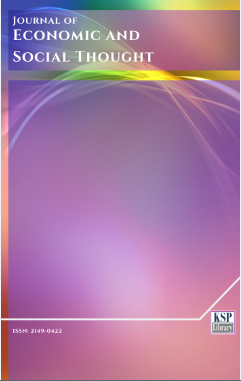Classicals versus Keynesians: A comprehensive table to teach 50 distinctions between two major schools of economic thought
Abstract
Abstract. Macroeconomics essentially discusses macroeconomic phenomena from the perspectives of various schools of economic thought, each of which takes different views on how macroeconomic agents make decisions and how the corresponding markets operate. Therefore, developing a clear, comprehensive understanding of how and in what ways these schools of economic thought differ is a key and a prerequisite for economics students to prosper academically and professionally in the discipline. This becomes even more crucial as economics students pursue their studies toward higher levels of education and graduate school, during which students are expected to attain higher levels of Bloom’s taxonomy, including analysis, synthesis, evaluation, and creation. Teaching the distinctions and similarities of the two major schools of economic thought has never been an easy task to undertake in the classroom. Although the reason for such a hardship can be multi-fold, one reason has undoubtedly been students’ lack of a holistic view on how the two mainstream economic schools of thought differ. There is strong evidence that students make smoother transition to higher levels of education after building up such groundwork, on which they can build further later on (e.g. Didia and Hasnat, 1998; Marcal and Roberts, 2001; Islam, et al., 2008; Green, et al., 2009; White, 2016). The paper starts with a visual spectrum of various schools of economic thought, and then narrows down the scope to the classical and Keynesian schools, i.e. the backbone of modern macroeconomics. Afterwards, a holistic table contrasts the two schools in terms of 50 aspects. Not only does this table help economics students enhance their comprehension, retention, and critical-thinking capability, it also benefits macroeconomic instructors to gain a holistic view and deliver such a view more easily in their classrooms. The pedagogical aspects of this approach are discussed throughout the paper with reference to the economics education literature.
Keywords. Classicals; Keynesians; Economic schools of thought; Teaching of economics; Macroeconomics, and pedagogy.
JEL. A10; A22; A23; B10; E10.
Keywords
References
Antonietta, C. (1987). Marginal economics, The New Palgrave: A Dictionary of Economics, 3, 323.
Arocha, J.F., & Patel, V.L. (1995). Novice diagnostic reasoning in medicine: accounting for evidence. The Journal of the Learning Sciences, 4(4), 355-384. doi. 10.1207/s15327809jls0404_1
Athreya, K. B. (2013). Big Ideas in Macroeconomics: A Nontechnical View. Mit Press.
Blaug, M. (1987). Classical economics, The New Palgrave Dictionary of Economics, v.1, pp.414-45.
Christiano, L.J., & Eichenbaum, M. (1995). Liquidity effects, monetary policy, and the business cycle. Journal of Money, Credit and Banking, 27(4), 1113-1136. doi. 10.2307/2077793
Clark, B.S. (1998). Political Economy: A Comparative Approach. ABC-CLIO.
DeJong, T., & Ferguson-Hessler, M.G. (1996). Types and Quality of Knowledge. Educational Psychologist, 8(2), 105–113.
Didia, D., & Hasnat, B. (1998). The determinants of performance in the university introductory finance course. Financial Practice and Education, 8, 102-107.
Fletcher, G.A. (1987). The Keynesian Revolution and its Critics: Issues of Theory and Policy for the Monetary Production Economy. Springer.
Fletcher, G. (1989). The Keynesian Revolution and Its Critics: Issues of Theory and Policy for the Monetary Production Economy. Palgrave MacMillan.
Galí, J. (2015). Monetary Policy, Inflation, and the Business Cycle: An Introduction to the New Keynesian Framework and its Applications. Princeton University Press.
Goodfriend, M., & King, R.G. (1997). The new neoclassical synthesis and the role of monetary policy. NBER Macroeconomics Annual, 12, 231-283.
Green, J.J., Stone, C.C., Zegeye, Z., & Charles, T. (2009). How much math do students need to succeed in business and economics statistics? An ordered probit analysis. Journal of Statistics Education. 17(3). doi. 10.1080/10691898.2009.11889532
Hayes, M. (2008). The Economics of Keynes: A New Guide to the General Theory. Edward Elgar Publishing.
Islam, F., Khan, S. Wilson, I., & Gooch, R. (2008). The value of prerequisite courses for statistics. Journal of Business Inquiry, 7(1), 61-67.
Jahan, S., Mahmud, A.S., & Papageorgiou, C. (2014). What is Keynesian economics. Finance & Development, 51(3), 53-54.
Lawson, T. (2006). The nature of heterodox economics. Cambridge Journal of Economics, 30(4), 483-505. doi. 10.1093/cje/bei093
Lee, F.S. (2008). Heterodox Economics, The New Palgrave: A Dictionary of Economics.
Mankiw, N.G. (2006). The macroeconomist as scientist and engineer. The Journal of Economic Perspectives, 20(4), 29-46. doi. 10.1257/jep.20.4.29
Marcal, L., & Roberts, W.W. (2001). Business statistics requirements and student performance in financial management. Journal of Financial Education, 27(3), 29-35.
McCandless Jr, G.T., & Weber, W.E. (1995). Some monetary facts. Federal Reserve Bank of Minneapolis. Quarterly Review-Federal Reserve Bank of Minneapolis, 19(3), 2-11. doi. 10.21034/qr.1931
Moosavian, S.A.Z.N. (2016a). The visual “big picture” of intermediate macroeconomics: A pedagogical tool to teach intermediate macroeconomics. International Journal of Economics and Finance, 8(9), 234. doi. 10.5539/ijef.v8n9p234
Moosavian, S.A.Z.N. (2016b). Teaching economics and providing visual “big pictures”. Journal of Economics and Political Economy, 3(1), 119-133.
Moosavian, S.A.Z.N. (2017). Using the interactive graphic syllabus in the teaching of economics. American Journal of Business Education, 10(2), 45-64.
Moosavian, S.A.Z.M. (2017). Why is it so hard? Identifying the root causes of the hardship of transitioning from undergraduate macroeconomics to graduate macroeconomics. Manuscript in preparation.
Naumenko, A., & Moosavian, S.A.Z.N. (2016). Clarifying theoretical intricacies through the use of conceptual visualization: Case of production theory in advanced microeconomics, Applied Economics and Finance, 3(3), 103-122. doi. 10.11114/aef.v3i4.1781
Nilson, L.B. (2009). The Graphic Syllabus and the Outcomes Map: Communicating Your Course (Vol. 137). John Wiley & Sons.
Schools of Economic Thought. (2017, March 21). In Wikipedia, The Free Encyclopedia. Retrieved 15:42, May 15, 2017, [Retrieved from].
"The Neoclassical-Keynesian Synthesis". The History of Economic Thought Website. The New School. Retrieved 2009-04-23.
White, M.L. (2016). Do leveling courses prepare students for graduate study? Paper presented at the 86th Southern Economic Association, Washington, D.C., USA.
Woodford, M. (2009). Convergence in macroeconomics: elements of the new synthesis. American Economic Journal: Macroeconomics, 1(1), 267-279. doi. 10.1257/mac.1.1.267
DOI: http://dx.doi.org/10.1453/jest.v9i2.2325
Refbacks
- There are currently no refbacks.
Journal of Economic and Social Thought - J. Econ. Soc. Thoug. - JEST - www.kspjournals.org
ISSN: 2149-0422
Editor: [email protected] Secretarial: [email protected] Istanbul - Turkey.
Copyright © KSP Library




